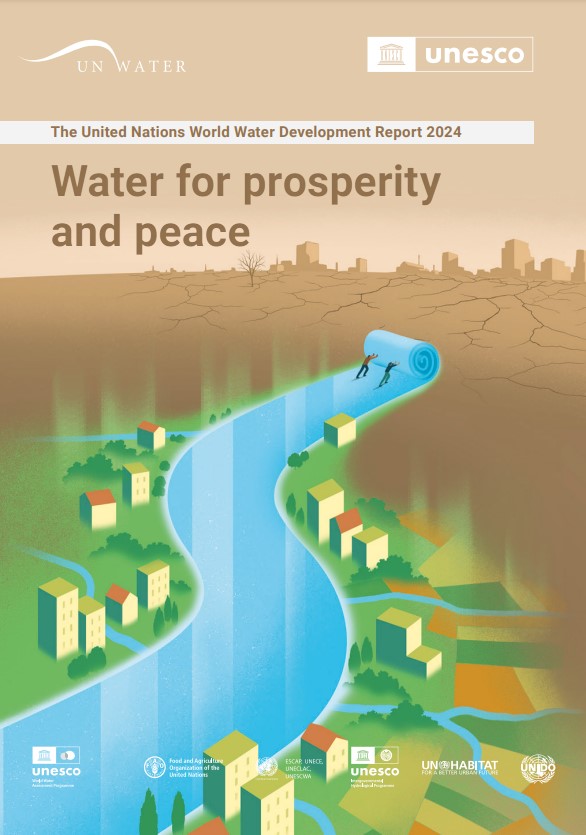
□ 보고서는 기후변화로 인한 기록적 가뭄과 폭우의 증가, 그리고 세계 담수 시스템의 남용 및 오염으로 인해 수자원 위기가 심각해지고 있다고 밝혔음. 유엔 세계 물 개발 보고서의 편집장 리처드 코너는 ”폭력적 분쟁, 전염병, 지구 온난화, 초인플레이션, 대량 이주 및 기타 위기는 모두 물의 영향을 받고 또 물에 영향을 미친다”고 설명함. 예컨대 아프리카 중부 차드에 있는 '차드호'(Lake Chad)의 크기가 사막화로 인해 지난 60년 동안 90% 줄어들면서 인근 국가인 카메룬, 중앙아프리카공화국, 리비아, 니제르, 나이지리아의 경제, 안보 상황이 악화되었다고 지적함
□ 보고서는 ”효과적이고 공평한 물 배분은 궁극적으로 사회 통합을 촉진한다”며, 저소득 국가에 대한 물 관련 투자의 질 향상 및 투자 금액 확대가 필요하다고 밝혔음. 또한 이를 위해서는 공공 및 민간 재원이 모두 필요하다고 촉구함
[출처]
유엔 '세계 인구 22억명 식수 부족…평화 위협' (2024.03.22.) / 연합뉴스
물 부족, 여성·어린이에게 더 큰 고통…UN ‘물 개발 보고서’ 지적 (2024.03.22.) / 한겨레
목차
Foreword by Audrey Azoulay, Director-General of UNESCO xi
Foreword by Alvaro Lario, Chair of UN-Water and President of IFAD xiii
Preface xiv
UN WWDR 2024 Team xvi
Acknowledgements xvii
Executive summary 1
Prologue 9
The state of the world’s freshwater resources 10
Progress towards SDG 6 14
Water and prosperity 16
Water and peace 18
References 19
Chapter 1: Introduction 22
1.1 Key concepts 24
1.2 Adjusting to accelerating complexity and change 25
References 26
Chapter 2: Agriculture and rural development 27
2.1 Ensuring water and food security 28
2.2 Investing in irrigation and agricultural water productivity 29
2.3 Climate change impacts on food security 32
2.4 Agriculture and water governance 34
2.5 Transforming agricultural water management 35
References 39
Chapter 3: Human settlements: WASH, disaster risk reduction and migration 41
3.1 WASH for displaced and conflict-affected populations 42
3.2 WASH as a peace-making tool in fragile and conflict-affected contexts 43
3.3 Disaster risk reduction 44
3.4 Migration and forcibly displaced populations 46
References 48
Chapter 4: Industry 50
4.1 Interactions and impacts with water 51
4.2 Methods of leveraging 53
4.3 Industry, water and peace 56
4.4 Conclusions 58
Chapter 5: Energy 61
5.1 Water for energy 63
5.2 Energy for water 67
5.3 The water–energy–climate change nexus 68
References 71
Chapter 6: Environment 73
6.1 Ecosystem services: trends and lost opportunities 74
6.2 Nature, conflict and peacebuilding 75
6.3 Valuing nature 76
6.4 Nature-based solutions 76
6.5 Response options 80
References 81
Chapter 7: Transboundary cooperation 83
7.1 Transboundary water agreements and institutions 85
7.2 Role of transboundary water cooperation in conflict and post-conflict settings 85
7.3 Inclusive, participatory transboundary processes 86
7.4 Groundwater and transboundary aquifers 87
7.5 Trends and conclusions 88
References 89
Chapter 8: Regional perspectives 91
8.1 Sub-Saharan Africa 92
8.2 Europe and North America 95
8.3 Latin America and the Caribbean 98
8.4 Asia and the Pacific 101
8.5 Arab region 104
References 108
Chapter 9: Governance 112
9.1 Linking water governance with prosperity and peace 113
9.2 Water governance and allocation 114
9.3 Water development paths 118
References 119
Chapter 10: Science, technology and information 121
10.1 Science, technology and innovation 122
10.2 Data and information 123
10.3 Conclusions 128
References 129
Chapter 11: Education and capacity development 131
11.1 Water and education in conflict situations 133
11.2 Scientific and technical skills 133
11.3 Social, legal and policy skills 134
11.4 Public awareness and widening participation 134
11.5 Looking forward 135
References 136
Chapter 12: Financing water security and mitigating investment risks 137
12.1 Investment planning in water resource management 138
12.2 Optimizing water supply and sanitation investments 139
12.3 Mobilizing investment for water infrastructure 140
12.4 Reducing investment exposure to water-related risks 142
12.5 Conclusions 145
References 145
Chapter 13: Conclusions 147
The water–prosperity paradox 148
Water: agent of peace or instrument of conflict? 148
Global trends: threats and opportunities 149
Coda 151
Abbreviations and acronyms 152



